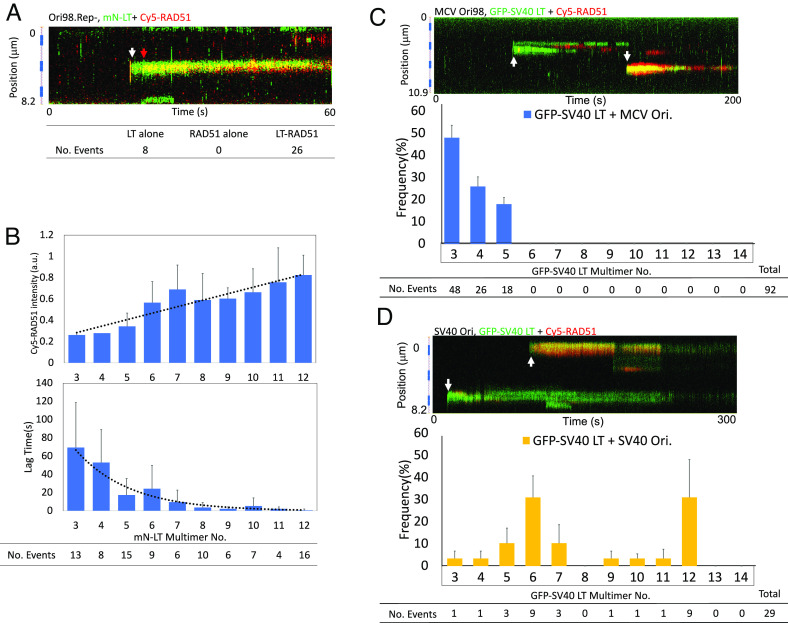Fig. 5.
Partially assembled MCV or SV40 LT proteins melt MCV origin dsDNA. (A) ssDNA RAD51 binding occurs after LT assembly on Ori98.Rep-. A representative kymograph from 26 colocalization events for mN-LT (green) and Cy5-RAD51 (red) bound to Ori98.Rep- using six DNAs. The white arrow marks initial mN-LT DNA binding, and the red arrow marks subsequent Cy5-RAD51 assembly. (B) RAD51 cobinding was proportional to LT multimerization and lag time for RAD51 cobinding, after LT binding, decreased exponentially with size of the initially bound LT multimer. (Top) maximum Cy5-RAD51 fluorescence vs. mN-LT molecule assembly number on wild-type Ori98 for dual LT-RAD51 binding events (n, 94). Increased LT multimerization was associated with increased RAD51 ssDNA deposition, R2 = 0.8608 for a linear regression, and F = 49.48 for the F-test with P = 0.0001. six DNAs, 5 min exposure each. No RAD51 binding was seen for 52 origins that did not bind LT during the experiment. (Bottom) lag time between initial mN-LT and initial Cy5-RAD51 binding to the same origin for dual LT-RAD51 binding events (n, 94). Lag time was inversely related to initial LT multimerization. Dodecameric mN-LT recruited Cy5-RAD51 almost immediately, whereas trimeric mN-LT required 67 s (on average) to attract Cy5-RAD51 binding, R2 = 0.9509 for an exponential regression. (C) Nonreplicative SV40 LT melts MCV origin. (Top) GFP-SV40 LT (green) did not form hexamers on MCV Ori98 but was associated with DNA melting and subsequent Cy5-RAD51 (red) colocalization (white arrows). (Bottom) frequency of estimated SV40 LT-GFP multimers initially binding to MCV origin. Data collected from 12 DNAs, 5 min each. (D) SV40 LT melts the SV40 origin. GFP-SV40 LT (green) was associated with DNA melting and Cy5-RAD51 (red) colocalization (white arrows) on SV40 origin. (Bottom) frequency of estimated SV40 LT-GFP multimers initially binding to SV40 origin showed preferred hexamer and dodecamer assembly. Data were collected from six DNAs, 5 min each. Notably, sub-double-hexameric SV40 LT binding events were also observed to melt SV40 origin in a fashion similar to MCV LT on MCV origin.

